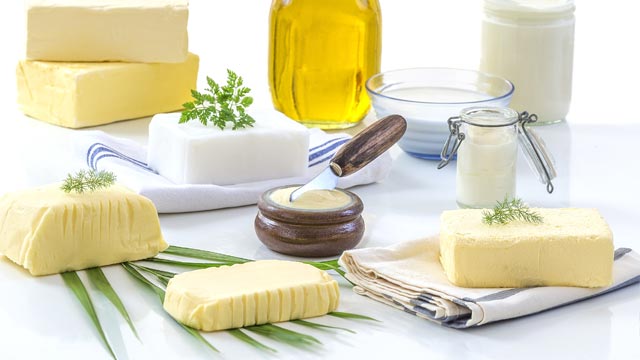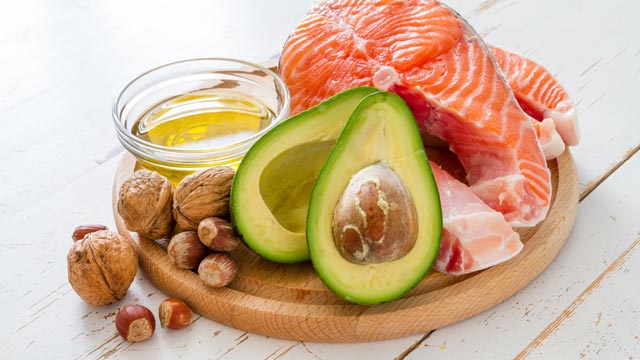Follow us 261.1k
The main focus of the ketogenic diet is to get the macronutrient ratio right. Ideally, you should be eating 5-10% calories from carbs (net carbs), 15-30% of calories from protein and 65-75% calories from fat (or even more) in order to benefit from ketone bodies produced by your liver.
So, what is the ideal fat intake on the ketogenic diet? The amount of fat varies for all individuals and depends on your goal. In general, you won't need to precisely count fat intake or calories on a ketogenic diet, because eating food naturally low in carbs will keep you sated for longer.
In studies, proteins and fats have been shown to be the most sating nutrients, and carbohydrates the least sating. Fat provides a steady supply of energy with no insulin spikes. That's why, you won't experience any cravings or energy and mood swings.
However, in some cases counting calories and keeping track of your macros make help you break through a weight loss plateau. If you want to find out your ideal fat intake, have a look at KetoDiet Buddy, a free online keto calculator we have developed for our blog. All the recipes on my blog and in KetoDiet Apps include detailed nutrition data to help you track your food intake.
Furthermore, the macronutrient ratio is not the only aspect you should consider. When increasing your fat intake, it's critical to understand which fats are beneficial and which may damage your health. Simply put, the type and quality of fats matter. When deciding which oils and fats you should use, follow rules below.

1. Use Saturated Fats for Cooking
Saturated fats have been cursed and deemed to be really bad for our health. We've been brainwashed for the last 50 years that saturated fat and cholesterol are the major causes for coronary heart disease and obesity. The entire lipid hypothesis was based on bad science - the flawed and fraudulent research of Ancel Keys.
If you still believe that saturated fat and cholesterol are bad, check out my post here: The Obesity Epidemic, the Truth about Cholesterol and Saturated Fat.
Saturated fats are found in red meat, cream, butter, ghee, lard, tallow, eggs, coconut oil and palm oil (use organic from sustainable agriculture).
They are the most stable, have long shelf lives and high smoke points. Use these oils for most of your cooking. In fact, most of your fat intake should come from saturated and monounsaturated fats.
2. Add MCTs to Your Diet
Medium-chain triglycerides (MCTs) are saturated fats our body can digest very easily. MCTs, which are mostly found in coconut oil, behave differently when ingested and are passed directly to the liver to be used as an immediate form of energy. They are also present in butter and palm oil in smaller quantities.
MCTs are used by athletes to improve and enhance performance and may even boost fat loss. If you can tolerate pure MCT oil with no stomach discomfort, you can get it in a supplement form on Amazon.
3. Include Heart-healthy Monounsaturated Fatty Acids
Monounsaturated fatty acids (MUFA, omega 9, including oleic acid) are found in avocados, olives, meat and nuts (especially macadamias) and have been known to prevent heart disease. Studies show that consumption of monounsaturated fatty acids is associated with better serum lipid profiles.
Oils high in MUFA such as extra virgin olive oil, avocado oil and macadamia nut oil are best for cold use (MUFA are less stable than SFA), for finishing meals or after cooking.

4. Use Unsaturated Fats But Don't Heat Them
The polyunsaturated fatty acids (PUFA), omega 3 and omega 6, are both essential and our bodies need them. However, our diet is often loaded with PUFA and we eat too many of them.
They are called "poly", because they contain many double bonds which tend to react with oxygen when heated and form harmful compounds such as free radicals. Consuming oxidative fats creates free radicals and increases inflammation in our bodies and the risk heart disease and cancer. Chris Kresser suggests that total intake of PUFA should be no more than 4% of daily calories.
In general, polyunsaturated fats are unstable and not suitable for high-heat cooking. Organic, extra virgin olive oil, nut oils, sesame oil, flaxseed oil, avocado oil are best for cold use. While flaxseed oil should never be heated and should always be refrigerated, some oils (avocado, macadamia, olive) can be used for finishing your meals or light cooking.
5. Balance Your Omega 6 and Omega 3 Fatty Acids
Both omega-3 and omega-6 fats are essential, polyunsaturated fatty acids. However, studies show that Western diets are deficient in omega 3 fatty acids. In fact, the omega 3 to omega 6 ratio is very unfavourable (15:1 – 17:1). Ideally, this ratio should be balanced at 1:1. The closer you get to this ratio, the better it will be for your health. Studies show that while elevated intake of omega 6 and deficient intake of omega 3 fatty acids are associated with cardiovascular disease, stroke, autoimmune disorders and other inflammatory diseases, reduced intake of omega 6 may protect against these diseases.
Because it's likely you are already getting enough omega-6, focus on increasing your intake of omega-3 foods, such as wild salmon, fermented cod liver oil, grass-fed meat, walnuts and macadamia nuts.
6. Use Animal Sources for Most of Your Omega 3 Intake
Omega 3 fatty acids are either short-chain (alpha-linolenic acid, ALA) mostly found in seeds and nuts or long-chain (eicosapentanaenoic acid , EPA and docosahexaenoic acid, DHA) found in fish and seafood. While EPA and DHA favourably affect omega 6 to 3 ratio, ALA first needs to be converted to EPA or DHA. Unfortunately, our bodies are extremely inefficient at converting ALA to EPA and DHA ( study 1, study 2). That's why it's so important to get omega 3 fatty acids primarily from animal sources.
When using animal sources, always opt for grass-fed meat for maximum omega 3 fatty acids. In fact, grain-fed meat is low in omega 3 but loaded with omega 6 fatty acids.
7. Focus on Smoke Point, Oxidation Rate and Shelf Life
The higher the smoke point is, the better. In general, oils with high smoke points can be cooked at higher temperatures. Heating oil above its smoke point damages the oil and loads it with free radicals.
The slower the oxidation rate is, the better.
Heating oil up to its smoke point will increase its oxidation rate. However, oils and fats can oxidize even on the shelf when exposed to oxygen, light, moisture and even temperatures below their smoke point. Also, metals like iron and copper can act as pro-oxidants.
All oils can go rancid on a shelf which often loads them with free radicals. In general, oils high in saturated fat last longer (12-24 months) than oils high in monounsaturated (6-12 months) or polyunsaturated fats (2-6 months).

8. Avoid All Unhealthy Oils
Processed vegetable oils, margarine, hydrogenated oils, partially hydrogenated oils and other trans fats, interesterified fats - sunflower, safflower, cottonseed, canola, soybean, grapeseed and corn oil are all damaging to your health. Trans fatty acids and processed oils:
- are oxidized during high-heat processing which creates free radicals
- are often made from genetically modified seeds
- are pro-inflammatory and bad for your gut health
- consumption of trans fats increases risk of coronary heart disease
- consumption of trans fats negatively affects cholesterol levels - reduces concentrations of HDL cholesterol ("good" cholesterol) and increases concentrations of low-density LDL cholesterol ("bad" cholesterol)
- are associated with increased risk of cancer
Trans fats do exist in nature but also occur during the processing of polyunsaturated fatty acids in food production. Naturally occurring trans fats haven’t been shown to be harmful, although research is admittedly lacking. Natural trans fats are found in dairy products and meat from grass-fed animals.
Artificial trans fats are referred to as "metabolic poison". Eliminate these from your diet by avoiding foods that contain hydrogenated or partially hydrogenated oils. These types of trans fats are typically found in margarines, cookies, crackers or even French fries.
Do you like this post? Share it with your friends!
Let us know what you think, rate this post!
